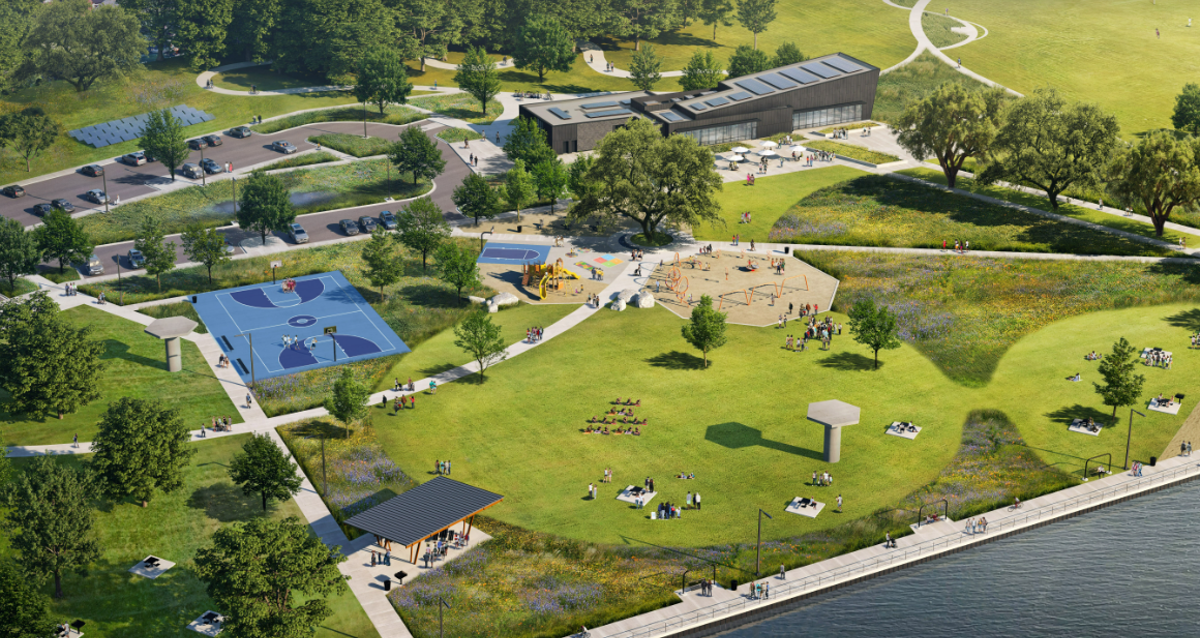A week after the city of Detroit alerted residents in a last-minute Zoom meeting that it was closing a waterfront park on the east side after finding contamination in the soil, Mayor Mike Duggan’s administration has refused to divulge any further details.
Now residents in Jefferson Chalmers are left wondering if they’ve been exposed to dangerous contaminants at A.B. Ford Park, which was a Nike missile site in the 1950s. Those sites are notorious for leaving behind a toxic cocktail of contaminants, though it is not believed that any missiles were ever stored at the A.B. Ford Park site, which housed radar tracking towers and barracks for military personnel.
Residents are also incensed with the city’s insistence that it must remove more than 250 trees, some of which are more than 100 years old and are used by bald eagles. The city claims the best way to protect residents from the contamination is by adding two feet of fresh soil to the 32-acre park, which would make it impossible for the trees to survive.
To cover the park with new soil, an average of 20 to 30 heavy trucks would trudge through the neighborhood every day from March to September, the city said.
The city plans to replace the trees with hundreds of native and flowering trees, according to a city document.
After news broke about the park’s closure on Friday, the city abruptly canceled a meeting with residents.
Terry Swafford, who takes his two children to the park almost every day, has been trying to get more information from the city, to no avail.
In a phone conversation last week with Crystal Perkins, director of the city’s General Services Department, Swafford says he was told Detroit had to spend the money quickly.
None of this adds up to Swafford and his neighbors. The city has been testing the park for contaminants for years and never mentioned finding toxic chemicals. In fact, the city renovated the western portion of the park last year and added no new soil.
He’s skeptical that there’s any good reason to remove the trees.
“This is disastrous, and no one wants it,” Swafford tells Metro Times. “All of my neighbors are up in arms about it, and they feel powerless. This is a no-win for us. This is horseshit, and the city knows it.”
Swafford says residents have reached out to his city councilwoman, Latisha Johnson, but she never called them back.
When Metro Times asked for specifics about the contamination, the city declined to release details. The city also refused to divulge the funding source, the identities of the contractors, and whether there was even a bidding process.
Even for the city of Detroit, this level of secrecy is unusual.
Earlier this week, Duggan spokesman John Roach said he would try to answer Metro Times’s questions, but on Thursday morning, he declined, saying the administration will address the community during a meeting about the park on Thursday evening.
“The city is doing a full presentation on the soil contamination to the community at a meeting at 5:00 tonight,” Roach said in a text message. “That community report will be followed by the posting of all environmental reports on the city’s website early next week.”
Trouble is, that timing prevents residents from providing any insight until the process is almost complete.
After this story was published, a Detroit City Council committee voted to delay action on the $9.6 million plan at a meeting Thursday afternoon. Swafford says neither he nor his neighbors knew about the meeting until the last minute.
If the council approves the spending, the plan will move forward, without ample opportunity for residents to provide any meaningful insight.
Detroit resident Jay Juergensen, a flood protection expert and lead organizer of Jefferson-Chalmers WATER Project, says he has serious concerns about the plan and the city’s lack of transparency. Residents in Jefferson Chalmers have been inundated with flooded basements over the past few years, and he’s worried the plan could exacerbate the problem.
“All of my neighbors are up in arms about it, and they feel powerless. This is a no-win for us. This is horseshit, and the city knows it.”
tweet this
“What efforts are being made to ensure the proposed work is engineered in a manner that meets performance standards, including stability, seepage and settlement necessary to ensure it can provide flood protection or does not undermine future efforts for flood protection or put adjacent residents at great risk for flooding?” Juergensen tells Metro Times.
Residents also want to know if the area’s seawalls, which are intended to prevent flooding, are going to be raised since the ground is going to be two feet higher.
If the park is contaminated, it remains unclear why the city renovated the western portion, demolished an old building, and constructed a solar-powered recreation center last year. That building has large windows that are just inches above the ground. Adding two feet of soil around the building would put some of the building underground.
Without any answers, residents have no idea what to believe.
“If they had known it was contaminated when they took soil samples years ago, they would have done this remediation ahead of time [on the western portion] and there would have been two feet of extra soil,” Swafford says. “They didn’t follow their own recommendation. Are we to believe that it just became contaminated? None of this adds up. This should be obvious to anybody.”
From 1955 to 1960, the military used the property for radar tracking towers for missiles that were stored underground near Belle Isle. Towers from the Nike missile site are still standing at the park.
In Michigan, the military had 15 Nike sites, where workers handled hazardous chemicals. The Defense Department stationed thousands of surface-to-air missiles at about 250 Nike sites nationwide that were intended to protect major U.S. cities from aerial attacks during the Cold War.
Researchers discovered that these sites were rife with contamination.
“Normal operations of a Nike site included the use and onsite disposal of solvents, battery acids, fuel, and hydraulic fluid,” researchers found in a 1984 study. “Environmentally persistent compounds disposed of included carbon tetrachloride, trichlorethylene, trichloroethane, lead, and various hydrocarbons.”
Roach said it is believed that the contamination at A.B. Ford Park stems from the non-native fill material that was used to develop the site, which was once a marsh.
City officials hope to reopen the park in the fall. The park is undergoing renovations that will feature walkways, a playground, basketball court, fitness and picnic areas, tennis and pickleball courts, a fishing node, beach, and waterfront plaza.
But without more information, residents aren’t applauding the new amenities.
This story was updated with a clarification that no missiles were believed to have ever been stored at the site, as well as additional comments from the city’s spokesman.
Subscribe to Metro Times newsletters.
Follow us: Google News | NewsBreak | Reddit | Instagram | Facebook | Twitter







